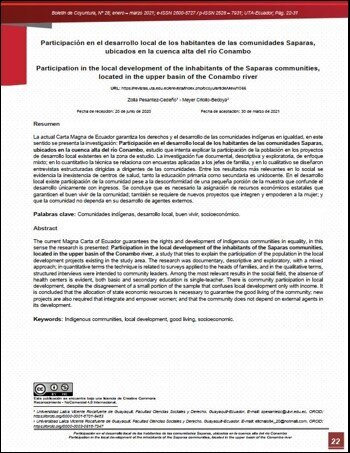Participation in the local development of the inhabitants of the Saparas communities, located in the upper basin of the Conambo river
Main Article Content
Abstract
The current Magna Carta of Ecuador guarantees the rights and development of indigenous communities in equality, in this sense the research is presented: Participation in the local development of the inhabitants of the Saparas communities, located in the upper basin of the Conambo river, a study that tries to explain the participation of the population in the local development projects existing in the study area. The research was documentary, descriptive and exploratory, with a mixed approach; in quantitative terms the technique is related to surveys applied to the heads of families, and in the qualitative terms, structured interviews were intended to community leaders. Among the most relevant results in the social field, the absence of health centers is evident, both basic and secondary education is single-teacher. There is community participation in local development, despite the disagreement of a small portion of the sample that confuses local development only with income. It is concluded that the allocation of state economic resources is necessary to guarantee the good living of the community; new projects are also required that integrate and empower women; and that the community does not depend on external agents in its development.
URL: https://revistas.uta.edu.ec/erevista/index.php/bcoyu/article/view/1066
Downloads
Article Details

This work is licensed under a Creative Commons Attribution-NonCommercial 4.0 International License.
![]()
The publications of the Boletín de Coyuntura are licensed under a Creative Commons Attribution-NonCommercial 4.0 International License (CC BY-NC 4.0). The Universidad Técnica de Ambato retains the copyright of the published works, and favors and allows the reuse of these, as long as: the authorship and original source of publication is cited, and they are not used for commercial or onerous purposes. The intellectual property of the published articles belongs to the authors.
References
Andrade, C. (2001). Kwatupama Sapara. Palabra Sapara. Recuperado de: https://digitalrepository.unm.edu/cgi/viewcontent.cgi?article=1491&context=abya_yala
Asamblea Constituyente del Ecuador (2008). Constitución de la República del Ecuador. Recuperado de: https://www.asambleanacional.gob.ec/sites/default/files/documents/old/constitucion_de_bolsillo.pdf
Bouzada, X. (1995). Elementos teóricos relativos al desarrollo comunitario local y su práctica en la comunidad autónoma de Galicia. Papers, Volumen (45), p. 88. Recuperado de: file:///C:/Users/Casa/Downloads/25266-Text%20de%20l'article-58771-1-10-20061201.pdf
Castillo, M., Félix, J., Mazabanda, C., Melo, M., Moreno De Los Ríos, M., Narváez, R.,...Ushigua, M. (2016). La cultura Sapara en peligro ¿Otro sueño es posible?. Recuperado de: https://www.pachamama.org.ec/wp-content/uploads/2019/06/La-Cultura-Sapara-en-Peligro.pdf
Castro, F. (2003). El proyecto de Investigación y su esquema de elaboración. Caracas, Venezuela: Uyapar.
Cummins, I. y Nilan, S. (2018). Plan de Manejo Integral de las Comunidades Saparas del Alto Rio Conambo 2018-2027. Quito, Ecuador:
Fundación Friedrich Ebert (2018). Raíces latinoamericanas del otro desarrollo: estilos de desarrollo y desarrollo a escala humana, en Más allá del PIB hay vida: Una crítica a los patrones de acumulación y estilos de desarrollo en América Latina. Recuperado de: http://library.fes.de/pdf-files/bueros/mexiko/14962-20190222.pdf
García de la Cruz, J. (2018). Antonio Vázquez Barquero. La práctica como teoría y la teoría como práctica de un economista del desarrollo. Recuperado de: http://www.encuentros-multidisciplinares.org/revista-58-59/jose_manuel_garcia_de_la_cruz.pdf
Gobierno Autónomo descentralizado Parroquial Rural de Sarayaku (2015). Plan de Desarrollo y Ordenamiento territorial de la Parroquia Rural de Sarayaku. Recuperado de: http://app.sni.gob.ec/sni-link/sni/PORTAL_SNI/data_sigad_plus/sigadplusdocumentofinal/1660011450001_PDOT%20SARAYAKU_30-10-2015_18-31-39.pdf
Naciones Unidas. (2018). La Agenda 2030 y los Objetivos de Desarrollo Sostenible: una oportunidad para América Latina y el Caribe. Recuperado de: https://repositorio.cepal.org/bitstream/handle/11362/40155/24/S1801141_es.pdf
Secretaria Nacional de Planificación y Desarrollo e Instituto para el Ecodesarrollo Regional Amazónico (2016). Plan Integral para la Amazonia. Recuperado de: http://extwprlegs1.fao.org/docs/pdf/ecu166986anx.pdf
Tapia, A. (2018). Comunidades indígenas amazónicas y la importancia de REDD+ en Ecuador. Estudio de caso de la nacionalidad Sapara, provincia de Pastaza. Recuperado de: http://repositorio.uasb.edu.ec/handle/10644/6116
Vázquez, A. (2007). Desarrollo Endógeno. Teorías y Políticas de Desarrollo Territorial. Investigaciones Regionales, p. 206. Recuperado de: https://investigacionesregionales.org/en/article/desarrollo-endogeno-teorias-y-politicas-de-desarrollo-territorial/


